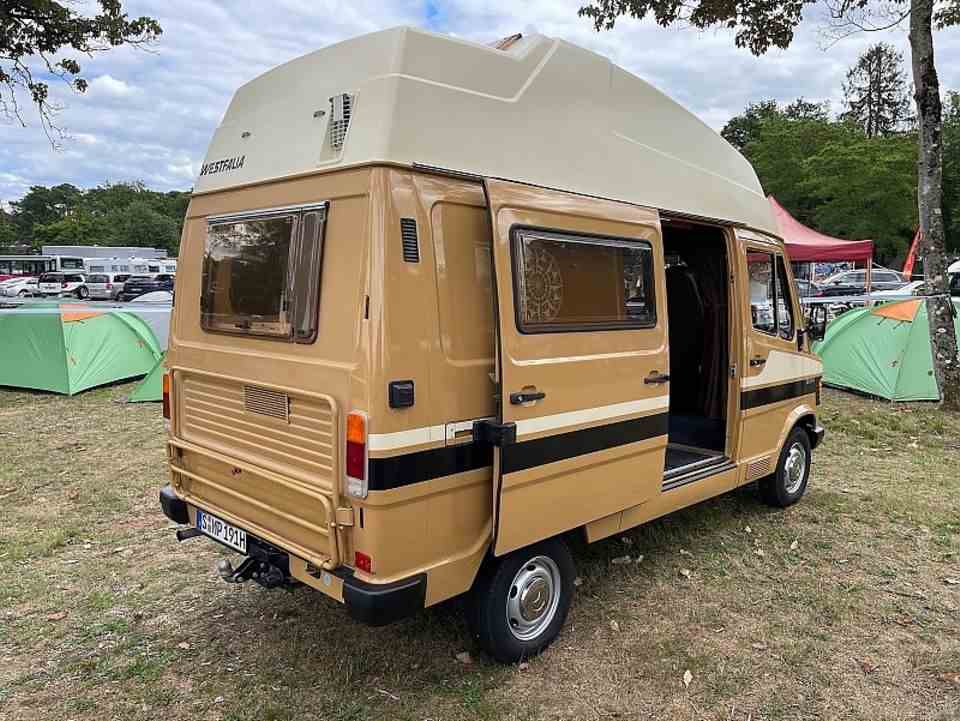Classic Mercedes, Camping, Mercedes 209 D
An early explorer
Mercedes 209 D Marco Polo 1984
© press-inform – the press office
Camping is more popular than ever. The ongoing corona pandemic has given people even more of a taste for freedom on wheels. Almost 40 years ago it looked a little different – just like the mobile homes. We make a journey through time in the Mercedes 209 D, the first Marco Polo mobile home.
You have to get used to this color first. Back then, many people still knew Bahama beige from their parents’ bathroom at home. Warm, cozy and cuddly – the first Marco Polo camper probably wanted to spread this atmosphere in 1984 with its contemporary exterior paint finish and corresponding interior. France became European soccer champion in the same year, Helmut Kohl was in fact already Federal Chancellor and the camping summer went down in the history of the Federal Republic as rather mixed. It was not an easy start for the first Marco Polo from Westfalia, which was based on the Bremen T1 transporter with the star, and so the debut work also wore the black plastic signet on the fenders, which pointed to a diesel engine that was quite powerful at the time. The Mercedes 209 D is powered by a five-cylinder type OM 617, which rattles loudly when starting, which delivers 65 kW / 88 hp without charging and delivers an impressive 172 Nm to the crankshaft. Despite the stately camping structure and the corresponding equipment, a top speed of 120 km/h is possible. However, it gets loud much earlier in the stub hood.
In particular, the high roof structure makes the first Marco Polo Camper so powerful in addition to its 80s paintwork. While the roofs of such mobile homes nowadays stretch into the sky at the push of a button, the structure of the Westfalia 209er was static and almost three meters high. With a height of 1.99 meters, today’s Marco Polo based on the Mercedes V-Class still ducks into most car parks and has no problems with low bridges or toll roads. As was customary in the 1980s, the sliding door still opened roughly mechanically – you were traveling in a transporter that lacked any limousine comfort of the time. However, the overall package of the first Marco Polo is comparable to today’s, apart from the color errors in the interior and countless practical storage areas, because there was space for four people in a manageable traffic area. So two people could sleep in the high roof and there was a convertible seat in the middle of the vehicle, which was formed from the two benches. If the worst comes to the worst, there would also be an emergency bed above the two front seats – but not only then would Amnesty International intervene at maximum occupancy. As is the case today, this camper should never be occupied by more than two people, and even then it is anything but comfortable at a length of less than 4.80 meters.
The mental freedom of the campers was lived out with rotating front seats, a kitchenette with a sink and refrigerator, and a two-burner stove. Then as now, the cooker and refrigerator could be operated variably with gas, 12-volt on-board electricity or 220 volts on the campsite. Then as now, nothing more was possible. From today’s perspective, the brown flocked velor on the two benches is just a matter of taste, as is the Bahama beige exterior paintwork with contrasting adhesive strips, which is slightly faded and can also be found in the tiny wash basin, which can also be used for a portable toilet if necessary. A door as a screen to the living room provides a touch of privacy. In the mid-1980s, the Marco Polo, based on the Mercedes van, was one of the classiest ways to travel in a compact camper van. In contrast to many a caravan, the cozy Mercedes 209 D has windows that can be opened – also colored in contemporary brown. Even more important for warm summer days on the campsite: fly screens and extendable blinds for the privacy that is so important. Air conditioning? Not to think about it and so in hot temperatures the only thing left to do was to pull through or jump into the lake or sea.
For the trip to the next domicile, the 209 driver’s workplace is just as unluxurious as the rest of the mobile accommodation from the 80s. The two-spoke steering wheel shows its descent from a small troop carrier and the instrumentation could hardly be more sparse. In addition to the speedometer, which promises an imaginary speed of up to 140 km/h, there are small round clocks for the time, tank and water temperature. To the right: heating control, ventilation, ashtray and a Becker radio, which created a good atmosphere on the long journeys, which could not have been endless. The odometer doesn’t even show 130,000 kilometers. The Asia explorer Marco Polo did not travel much with this vehicle.
In the living area at the rear, the Eberspächer auxiliary heating can be adjusted using a rotary knob, also colored brown – nobody had to freeze in the Marco Polo almost four decades ago. It’s practical that you don’t necessarily have to heave the clumsy sliding door open and closed to enter the living-dining-bedroom, which would probably have cost many a short-term friendship on the campsite. However, the two front doors do not close quietly either, and so the environment always knows at night when the neighbors are out and about. Finding a market price for such a Mercedes 209 D in the original Marco Polo trim is not easy, because there are practically no vehicles on the market. If you find one and want to immerse yourself in camping history, it should be worth more than 25,000 euros, depending on the condition.


